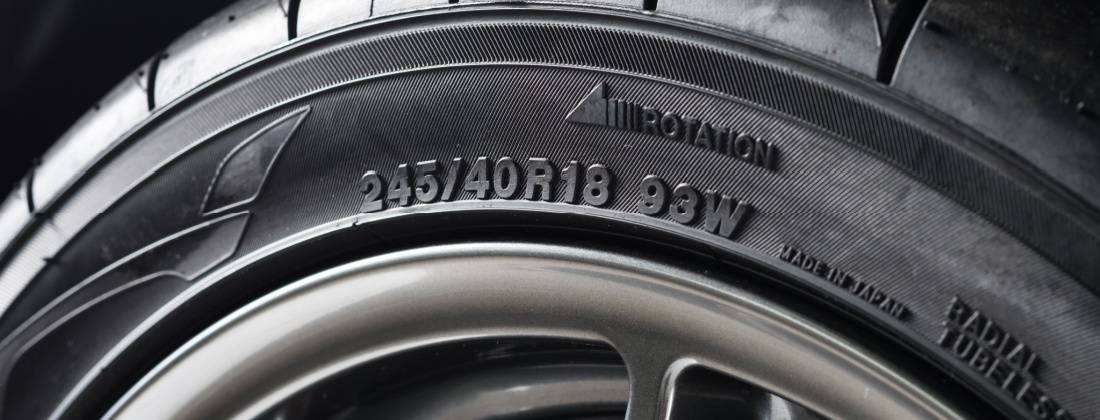What Do the Numbers and Letters on the Sidewall of My Tires Mean?
November 17, 2022
Tires

Quickly determining the tire size your vehicle requires by looking at the sidewall of your tires may save you time, effort, and money. Even though tire sizes are printed on the sidewall, only a few individuals can read them and understand them. The sidewall of a tire has everything you need to be familiar with about the tire, except the price. Letters and numbers are moulded into the rubber, each revealing important information about the tire’s features. All of these characters appear menacing at first glance. However, with some clarification, it’s simple to figure out what each one means.
Tire size
If you are shopping for tires, the first factor to consider for selecting the perfect tire for your car will be the size code. Verify the manufacturer’s recommended size for your car by referring to your owner’s manual or the driver’s side door.
This tire’s size code is P205/55R19, with a load index of 92 and a T speed assessment. It is a mud and snow-rated tire, as indicated by the M+S.
Type of Tire
The letter P (for passenger vehicles) at the front of the tire dimension code indicates that it is designed for light-duty use, such as a car or small pickup truck.
The letters LT (for light truck) may also appear before the tire size, indicating that the tire is intended for use on a pickup truck or SUV that requires a bit more power. The inflation pressures on these tires are usually higher than on passenger tires.
If there are no letters next to the start of a tire size, it is a Euro-metric tire. The load capabilities of Euro-Metric and P-Metric tires may differ. The appropriate tire dimension and inflation pressure for your vehicle can be found in your owner’s manual or on the tire placard.
Tire Thickness
Tire thickness or tire width is the breadth of the tire dignified from one sidewall to another in millimetres. The tire width is indicated by the paramount three digits of the tire dimension. The width of a size P215/65 R15 tire is 215 millimetres.
Construction
The tire’s construction is identified by the letter after the profile height. Most tires sold now have an R on them, indicating that they are radial tires. Other construction codes you could encounter include D for diagonal and B for bias belted, though they aren’t nearly as popular.
Aspect Ratio
This is the height of the tire’s cross-section divided by its width. The aspect ratio is the two-digit figure following the slash mark in tire size. In P215/65 R15 dimensions, for example, 65 indicates that the elevation is equivalent to 65 percent of the width of the tire. The larger the aspect ratio, the larger the sidewall of the tire will be.
Wheel Diameter
Is the wheel’s thickness measured from one end to the other? It specifies the wheel size that the tire is designed to fit. A P215/65 R15 rubber is designed for a 15-diameter wheel.
Load index & speed rating
The load index and speed mark are represented by the last set of characters linked to the tire type, size, and structure. The number denotes the maximum weight that can be supported by the tire when inflated correctly, while the letter represents the tire’s maximum speed capability.
A 92 load index, for example, indicates that the tire can support 1,389 pounds at full air pressure. To find your vehicle’s maximum load-carrying capability, proliferate that by 4 tires (4 x 1,389 = 5,556 lb). The letter T speed rating denotes a top speed of 118 miles per hour.
Although the size, structure, and type are the most crucial information to have when purchasing tires, the other letters, numbers, and symbols on the tire contain a wealth of additional information.
Treadwear
The treadwear classification is determined by the rate of wear exhibited by a tire throughout a 7,200-mile on-automobile test. The greater the number, the more durable the tire will be. For example, a treadwear score of 600 should provide more mileage than 400.
Traction
The traction score relates to the tire’s power to stop in a single direction on wet concrete and asphalt on a racing track within sterile environments. A, AA, B, and C are the available traction ratings, with AA providing the best stopping capacity and traction.
Temperature
The thermal rating indicates a tire’s resistance to overheating when driven at high velocities.
From A to C, the grades are given. Like in school, you’ll want an A because these tires are the most efficient at heat dissipation.
Treadwear, traction, and temperature and the three main components of the UTQG rating system to help you compare tires based on quality.
Rotation arrows
Various tread patterns are “unidirectional” or “directional,”; meaning they are intended to be mounted in a specified direction. When the car is driving along, these tires have an arrow indicating which direction the tire should spin.
If you’re looking for help deciphering these codes when you purchase your next set of tires, visit your local Trail Tire Auto Center, we are happy to help!
Back

